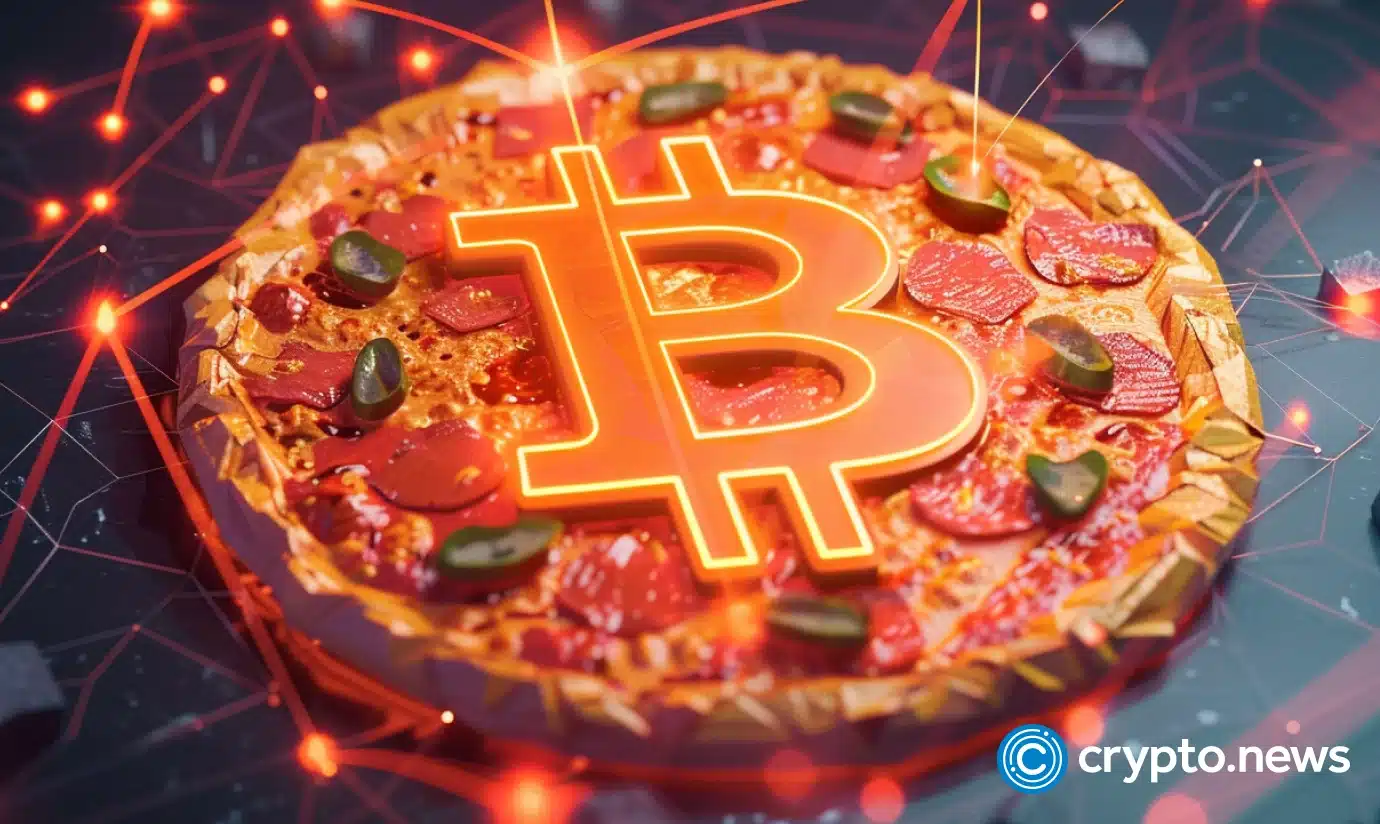What is Bitcoin Pizza Day? Celebrating a milestone in cryptocurrency history

Explore the significance of Bitcoin Pizza Day, marking the first documented Bitcoin transaction for physical goods, and its impact on the crypto world.
Every year, the crypto community celebrates a Bitcoin Pizza Day, a key event in the history of cryptocurrencies. But when is Bitcoin Pizza Day exactly, and why is it significant to the crypto community?
The day falls on May 22, and it’s the date when in 2010, Laszlo Hanyecz, a programmer and early Bitcoin (BTC) miner, made a transaction that would be remembered as the first documented use of Bitcoin to buy something tangible.
What did Hanyecz buy? Two pizzas for 10,000 BTC. However, the importance of this transaction extends beyond the pizzas. It represents the beginning of a global movement. Let’s take a closer look at this day’s history and its impact on the world of crypto.
Table of Contents
What is Bitcoin Pizza Day?
As stated previously, on May 22, 2010, Florida resident Laszlo Hanyecz agreed to exchange 10,000 Bitcoins for the delivery of two Papa John’s pizzas. The whole thing started earlier, on May 18, with Hanyecz expressing his desire on the BitcoinTalk forum for a couple of large pizzas that would ensure he had leftovers for the next day.
The essence of Hanyecz’s request was clear — he wanted the convenience of having food delivered in exchange for Bitcoins without the hassle of ordering or preparing it himself.
According to lore, it wasn’t until a few days later that a fellow forum user from the U.K. called Jeremy Sturdivant responded to Hanyecz’s offer and purchased the pizzas on his behalf, completing the transaction for 10,000 Bitcoins.
Interestingly, at the time Hanyecz made his Bitcoin for pizza deal with Sturdivant, they cost only $25. With Bitcoin in its infancy and its value a mere fraction of what it would become, the 10,000 BTC held a value of around $41. Fast forward to 2024, with Bitcoin trading at over $70,000, the value of the pizzas has soared to more than $700 million, highlighting the incredible journey of Bitcoin’s value appreciation over time.
The significance of Bitcoin Pizza Day
The Bitcoin for pizza story is celebrated as a technological revolution and invention of alternative money. According to industry watchers, it symbolizes more than just a pizza purchase; it represents the dawn of a new era in finance.
The event demonstrated that Bitcoin, once dismissed as a mere experiment, had real-world utility as a digital currency, sparking conversations and debates, igniting curiosity and driving adoption.
In 2010, following the global financial crisis, high inflation rates made some people see Bitcoin as a potential escape from the prevailing economic models and policies. Hanyecz’s purchase added real-world tangibility to the coin.
The impact of this event goes beyond just Bitcoin; it acted as a catalyst for the creation of new cryptocurrencies and spurred developments in blockchain technology and decentralized finance (DeFi).
Analysts believe that Hanyecz’s transaction highlighted Bitcoin’s practical value and its ability to function as a medium of exchange for physical goods. It also demonstrated the potential of cryptocurrencies to overhaul traditional financial systems and empower people to conduct transactions directly, bypassing the intermediaries and barriers of fiat currencies.
Moreover, the Bitcoin pizza story has evolved into an annual celebration embraced by the global crypto community, fostering a sense of unity and shared enthusiasm for the future of cryptocurrencies. Some crypto companies organize events worldwide, uniting enthusiasts, developers, and investors to honor the memorable moment.
On the day, people commemorate a historic transaction and remember the ongoing need for innovation and improvement in technology, including making crypto and blockchain more accessible, user-friendly, and embraced on a larger scale.
History of Bitcoin Pizza Day
We know that Hanyecz acquired his coins through mining on his laptop, a practice that was entirely feasible at the time due to the less competitive nature of Bitcoin mining on consumer-grade hardware.
However, the landscape has evolved significantly since then, with the industry becoming highly competitive. Large mining firms now invest millions of dollars in developing specialized hardware like ASICs (Application-Specific Integrated Circuits) to stay competitive.
Before the first Bitcoin halving in 2012, successful miners earned 50 BTC for each block mined. This meant that miners only needed to mine 200 blocks to accumulate 10,000 BTC, a task that was relatively straightforward due to the limited competition in the mining sector.
Initially, 10,000 BTC was worth $41, translating to a price per Bitcoin of roughly $0.004 when Hanyecz traded his coins for some Papa John’s pizza. Five years after the historic trade, Sturvidant reportedly sold his Bitcoins for approximately $400.
The day, now widely recognized, was not as popular before 2014 due to the relatively low awareness of Bitcoin. However, Hanyecz’s story gained traction in 2014, partly due to a New York Times article and popularization through a blog and tweet from the @Bitcoin X handle.
Interestingly, Laszlo Hanyecz’s impact on the early development of Bitcoin extended far beyond his famous pizza purchase. He is said to have made contributions to the network, addressing various vulnerabilities during its formative stages, and enhancing the protocol’s security and stability.
In addition to his efforts in network security, Hanyecz was also a trailblazer in software development. He was reportedly the first to release the Bitcoin code for Mac OS, a step that helped facilitate the widespread adoption of Bitcoin as a digital currency.
However, an intriguing question remains: does Laszlo Hanyecz still have Bitcoin? As of the time of this writing, the computer programmer hasn’t disclosed whether he still retains Bitcoins.
Nonetheless, in a CoinDesk interview four years ago, Hanyecz stated that he was employed as a developer at the GORUCK clothing company, and due in part to his online fame, the company was among those that accepted Bitcoin. According to him, GORUCK has been holding onto its Bitcoins, and has made significant gains over the years.
It’s also worth noting that the BTC Pizza Day is not the first “Bitcoin holiday.” In 2011, the crypto community celebrated the disappearance of Bitcoin creator Satoshi Nakamoto, who stepped down as project lead, with April 28 designated as “Satoshi Disappear Day” to mark this event.
Legacy and reflections
The Bitcoin pizza story lives on through annual commemorations by crypto enthusiasts worldwide. It serves as a reminder of Bitcoin’s humble beginnings and its journey to become a global phenomenon. Industry experts often reflect on the lessons learned from this event, highlighting the importance of adoption, usability, and community engagement in the crypto space.
As we reflect on the BTC Pizza Day, we are reminded of the transformative power of cryptocurrencies. What started as a pizza purchase has evolved into a thriving ecosystem, driving innovation, financial inclusion, and decentralized solutions.
The day encapsulates the spirit of innovation and experimentation that defines the cryptocurrency world. It reminds us that every transaction, no matter how small, can have a profound impact on the future.















